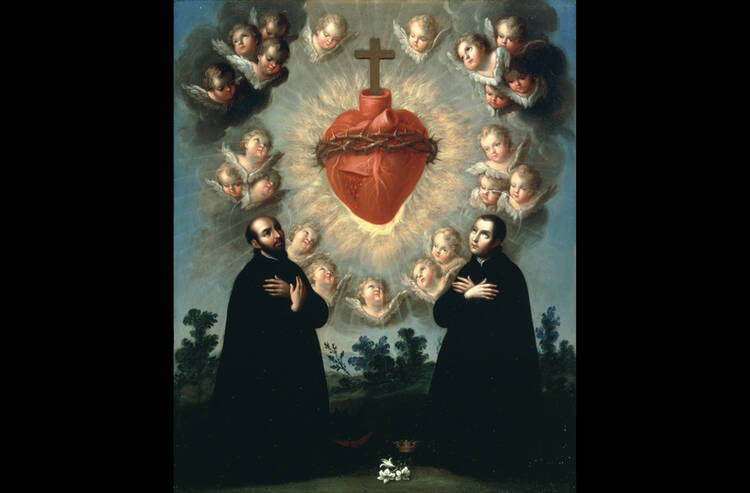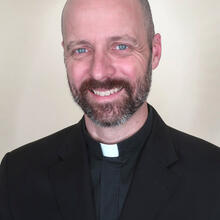A young woman prays quietly, kneeling on a wooden pew in a cool stone chapel. It is a night like many others. A chilly December breeze squeezes through the wooden window panes. The warm, sweet smell of candle wax and incense from the Christmas celebrations hangs on the altar and rafters. She turns the pages of a small prayer book, glancing up at the crucifix over the main altar.
Her life is not bad. She has friends and family that care for her. She suffers from occasional stress and has trouble sleeping. She can speak with a few friends about these issues and find support. Others find her a bit odd. She is clumsy, socially awkward, friendly and a bit nervous. And there is something else. She has never been able to name it. A stirring. A hope and desire for something, for someone. She feels it now. She hears something in the dark. Quiet at first but getting louder and more insistent. And sees something. Sees someone. Sees him. “Behold the Heart.”
Is she sleeping, dreaming, seeing things? “Behold.”
No. She wasn’t just seeing but being seen. Not just beholding but being both beheld and held. “Behold the Heart that has loved you so much.”
Is this real? Saints have seen him, of course. But I am not a saint, she thinks. But I am seeing him. He can do what he wants, even with a foolish sinner like me. “Behold.”
The essence of her prayer experience was this: “Jesus loves me. He loves all of us. He wants us to love him and others.”
It is Dec. 27, 1673, and in the weeks and months that followed, Margaret Mary Alacoque, V.H.M., would see visions of the Sacred Heart of Jesus in her convent chapel many times. She described his heart as pierced and bleeding, with flames, a crown of thorns and a cross above. She found these visions powerful, inspiring and confusing. Sometimes he came to her with very specific instructions: “Honor My Sacred Heart on the first Friday of each month. Tell your sisters to do the same.” Jesus also asked her to establish a feast honoring his heart after the feast of Corpus Christi.
When she talked with her community, she was met with a mix of reactions. Curiosity and belief, eye rolls and disbelief. She spoke with her superior, who was not sure what to make of all this. Was it true? Jesus did speak to saints. Was she a saint or a troubled young woman? Or both?
Her superior reached out to a young Jesuit priest who was new to the area. Claude Colombiere, S.J., had been chaplain to the king of England. But due to shifting alliances and political maneuvers, Father Claude was pushed out after a series of persecutions and imprisonment. He arrived at the French village sick and exhausted. People quickly saw his wisdom and faithfulness. Maybe he could help this young sister. Maybe he could make sense of her visions.
After a few conversations, Father Claude was convinced that these visions were from Christ himself. They were consistent with the faith of the church, with Scripture and tradition. In fact, there was nothing new here at all. The essence of her prayer experience was this: “Jesus loves me. He loves all of us. He wants us to love him and others.”
Contemporary images of the Sacred Heart are rooted in the revelations received by St. Margaret Mary. The light, the crown, the fire of his love and his pierced heart.
Yet he was speaking and revealing this message in a unique and powerful way. He was asking her to spread this message. As a cloistered nun, she had a limited social circle: her community, occasional letters, and a few friends and family members who came to visit her. Jesus later asked Sister Margaret Mary to tell Father Claude to preach this message as well. Thus, Father Claude became a great apostle of the Sacred Heart—through his homilies, retreats and writings—spreading this devotion around France and beyond.
The entire month of June is dedicated to the Sacred Heart, and on June 16, the church celebrates the annual solemnity of the Sacred Heart of Jesus. This feast is tied to the Easter season, so it slides around the spring calendar. It is always on a Friday and usually in June; it comes after the feast of Corpus Christi, which is two Sundays after Pentecost. On Corpus Christi, we honor the body and blood of Jesus present in the Eucharist. On this feast, we behold the love of Jesus shown in his heart, burning with love of us. See the close connection of these feasts: The human heart is composed of flesh and blood. After we receive eucharistic Communion, Jesus continues to invite us deeper into a “heart-to-heart” relationship with himself.
Contemporary images of the Sacred Heart are rooted in the revelations received by St. Margaret Mary. The light, the crown, the fire of his love and his pierced heart.
Who needs this devotion? Or who is the Sacred Heart for? You. The Sacred Heart is for you. If you are socially awkward, faithful but unsure of yourself like Margaret Mary, then your heart always has a home in the heart of Jesus. If your heart is broken by a shattered relationship or the loss of a loved one, you can find healing and wholeness in his heart. If you are an energetic young person, looking to set your heart on fire and share this flame with others, then the Sacred Heart is for you.
If you are faithful but unsure of yourself; if your heart is broken by the loss of a loved one; if you are an energetic young person, looking to set your heart on fire—the Sacred Heart is for you.
This year on Dec. 27, we begin a jubilee marking the 350th anniversary of St. Margaret Mary Alacoque’s first vision of the Sacred Heart. This jubilee will continue for 18 months, the length of her visions. It will include special Masses and events in Paray-le-monial, France, where her monastery is located. As with any church celebration, all people are invited to participate in varied ways—by praying privately or by organizing and participating in local celebrations.
One way to share in this jubilee: On the first Friday of every month, Jesus encouraged Margaret Mary and us to honor his heart. Priests are permitted to use special prayers at Mass. Catholics may choose to attend Mass on this day, say special prayers or engage in works of charity and service.
Families may wish to hang an image of the Sacred Heart in their homes or to honor the heart of Jesus in a prayer before meals. Simple coloring sheets are available online to help younger kids participate.
Jesuits will recall that Superior General Arturo Sosa, S.J., consecrated the Society of Jesus to the Sacred Heart on July 31, 2022. This occurred at the end of the Ignatian Year, celebrating 500 years since the conversion of St. Ignatius and 400 years since his canonization. Of course, this celebration was not exclusively for Jesuits—we encouraged our students, parents, teachers, alumni and others to join us in the prayers and festivities.
Honoring the saints and drawing closer to the heart of Jesus—that is a jubilee worth celebrating!
A portion of this article is an excerpt from Love Him Ever More, by Joe Laramie, S.J., and is reprinted with permission of the publisher, Ave Maria Press.








